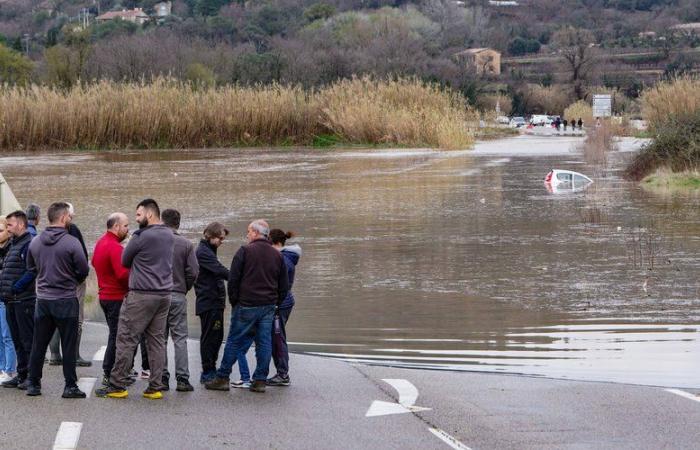
The tragedy in Valencia, on October 29, was a reminder of how ferocious nature can be. However, many experts have demonstrated that the human toll could have been less heavy, even though alerts had been issued earlier in the day. In France, where we once suffered deadly floods, we are trying to maintain this culture of risk management, particularly in the regions in the face of Cévennes or Mediterranean episodes.
The deadly bad weather in Spain on October 29 awakened bad memories on the other side of the border, particularly in the former Languedoc-Roussillon. If never, in recent decades, floods and floods have caused as many victims as in the Valencia region – the current toll shows at least 219 deaths –, certain Cevennes or Mediterranean episodes have still taken many lives. : 11 deaths in Nîmes in 1988; 35 in Aude, Pyrénées-Orientales and Hérault in 1999; 22 in Gard in 2002; 4 in the municipality of Lamalou-les-Bains alone in 2014; 5 the same year between Gard and Lozère; 4 still in Gard last spring… A list unfortunately not exhaustive.
On the other side of the Rhône, in Vaison-la-Romaine, 47 deaths were reported in 1992, after several waves of intense precipitation, up to 300 mm in less than six hours. It was this event which, along with that of Nîmes four years earlier, raised awareness. “Even if this is accelerating with global warming, events like that of Valence have existed around the Mediterranean since the dawn of time. Nîmes, Vaison-la-Romaine, it was the same images. But for the first time, we saw them on our televisions”, recalled Emma Haziza on the set of Quotidien last week.
“In Montpellier, at the same alert level, we stop the trams”
The hydrologist knows the subject perfectly. Founder of Mayane, a research center for territorial adaptation to climate change based in Montpellier, she was also an advisor to the prefects of Hérault and Gard in the management of flooding episodes. “We have learned from our mistakes, we have drawn lessons from the devastating events. Many actions have been put in place to reduce the number of victims: we support populations in carrying out work or even move people, we provide risk training children… And the alert system is well established. In Valence, there was the equivalent of a red alert and, however, people have not changed their behavior. In Montpellier, at the same level, we are stopping. the tram, we close colleges and schools, we leave people at home“, lists Emma Haziza.
This work really began after the terrible deadly floods of 2002, which pushed the executive to legislate. “With the security modernization law in 2004, mentalities have evolved,” believes Alix Roumagnac, president of the Montpellier-based company Prédict, founded in 2006 with the support of Météo France to provide territories threatened by climate risks with assistance in managing these phenomena.
Urban planning, awareness
In twenty years, various urban planning documents have emerged, starting with the natural flood risk plan, which delimits the exposed areas and the related measures to prevent or prohibit urbanization. The local authorities concerned then had to develop municipal – or inter-municipal – safeguarding plans which identify vulnerabilities and risks and provide the necessary organization to ensure alert, information, protection and support of the population with regard to the risks.
The law also imposed awareness-raising work among the general public, actions financed largely by the State through the “Papi”, plans to prevent natural flood risks. This may seem anecdotal, but to maintain collective memory, cities must also maintain flood markers.
An efficient chain
It is all this essential work that makes it possible to minimize the number of victims when the waves are carried away. “During the last biggest episode in France, storm Alex in the Nice hinterland which left 20 people missing, 600 mm fell in 8 hours, a meteorological event greater than Valence. In the feedback, we notes that all the municipalities have brought 3,000 people to safety by evacuating nursing homes, housing estates, parking lots, and closing bridges.”rewinds Alix Roumagnac, the first link in the chain by sending alerts as an event becomes clearer, both to communities, but also to insurers who pass on the message to their policyholders. “Between September and October, 20 million SMS messages broadcast safety messages“, he explains.
“After 4-5 years, we tend to forget”
Figures from recent years confirm lower mortality in France and in our region. But the four deaths at the start of the year, of Gard motorists swept away by the swollen river while crossing submersible bridges, show that we must never relax our efforts. “After 4 to 5 years after a disaster, apart from the victims, we tend to forget”analyzes Emma Haziza. Every year for the past nine years, as the critical period of autumn approaches, the prefect of the southern defense and security zone has launched an awareness campaign aimed at the 9 million people exposed to these weather phenomena. intense around the Mediterranean. He insisted this year on the fact that climate change made the risk greater despite all the efforts undertaken so far. It was a month before the tragedy in Valencia.
Occitanie, the most exposed region
A recent INSEE study highlighted how Occitanie remains sensitive to the problem. “27% of residents are exposed to the risk of rivers overflowing, or 1.6 million people”describes the analysis published on October 10.
This is particularly high around the Mediterranean, with 70% of the population concerned living in one of the four coastal departments. According to INSEE, 68,000 people aged 85 or over and 92,000 children under 6 are more vulnerable, particularly because a third of the establishments welcoming them, schools, hospitals or nursing homes, are located in these areas. . Nearly a third of economic activity is also located in a risk zone, which represents 160,000 establishments (including 40,537 in Hérault) and 418,000 employees. 300,000 places in tourist structures, particularly campsites, are also there. INSEE finally reveals that Occitanie is the region where the costs of damage linked to flooding are the highest: €3,855.5 million between 1995 and 2022, or €154.2 million per year.





